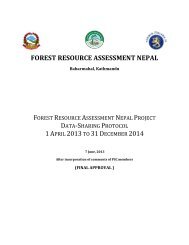Download - FRA Nepal
Download - FRA Nepal
Download - FRA Nepal
You also want an ePaper? Increase the reach of your titles
YUMPU automatically turns print PDFs into web optimized ePapers that Google loves.
7.3.1.2 Output and timetable<br />
Duty / Product<br />
Timetable<br />
Selection of remote sensing material 2 nd half of 1 st year<br />
Pre-processing: geometry, radiometry 2 nd half of 1 st year<br />
The map themes defined 2 nd year<br />
Thematic maps over <strong>Nepal</strong> 2 nd to 5 th year of the project<br />
The project staffs responsible for implementation:<br />
STA, Forest Information System and Remote Sensing Expert, Senior Remote Sensing and GIS Adviser, Senior Data<br />
Management Adviser (Regional) with short-term staff and national counterparts are responsible bodies.<br />
7.3.2 Capacity building<br />
In-service training will be provided to all employees doing visual interpretation. Image processing calls for training and it<br />
will be provided to personnel, who will be in charge of these activities. The training should cover the ortho-rectification and<br />
radiometric calibration procedures, image interpretation, use of auxiliary data, etc.<br />
7.3.3 Procurement<br />
The remote sensing material will be procured on the 2nd half of the 1st year of the project. The necessary software and<br />
hardware are procured on the 1st year of the project.<br />
7.4 Component 3: Open Source Forest Information System (OSFIS)<br />
7.4.1 Data sharing and dissemination<br />
The greatest technological innovation since the previous NFI in <strong>Nepal</strong> has been the emergence of the Internet. Internet access<br />
is currently available through wired and wireless channels, including even mobile phone networks. This makes it possible to<br />
share information over large distances and difficult terrain. The trend in forest organizations worldwide is to make forest<br />
information accessible with standard Internet browsers. This not only makes access cheap and ubiquitous, it also drastically<br />
shortens the learning curve, since modern FIS systems obey the same logic as web pages. Such an approach can be<br />
considered in <strong>Nepal</strong>, too, built on open source applications and tools used worldwide, but assembled and localised to<br />
<strong>Nepal</strong>ese conditions by a local IT company. The OSFIS becomes the central repository for the production of dynamic forest<br />
maps. It allows maps to stay up-to-date as new information is uploaded into database at the heart of the OSFIS.<br />
Interviews with potential users of the maps (i.e. national bodies, regional and district offices, and community forests) will be<br />
carried out and their information needs as well as the desired access method and frequency of these users will be<br />
documented. At this stage, it is also possible to look into gender issues and differences. The means of access – those available<br />
now, and those foreseen in coming years – will also be analysed (availability of computers and/or internet access, broadband<br />
capacity, possible preferences for forest cover map hardcopies). A system requirements document will outline the user<br />
interfaces needed for different user groups.<br />
The DFRS is and will be the responsible GoN branch for forest resource data production. The end-users of the data lie<br />
elsewhere and they are scattered in <strong>Nepal</strong>ese society, in governmental and non-governmental organizations. Inadequate data<br />
sharing was identified as one of the major problems in forest information management of <strong>Nepal</strong> (see Figure 1). To address<br />
this problem, a data sharing policy of the DFRS should be formulated. In the present-day society, data of this type should be<br />
publicly available, especially, when it is produced by state organization. In addition to public access to data, a data promotion<br />
and marketing efforts should be made to maximise the benefit of the <strong>FRA</strong> activities and to ensure continuity of the <strong>FRA</strong><br />
process. When data is needed and in active use, it is more likely that resources to continue the work will be allotted.<br />
The core components of the project produce basically two kinds of data:<br />
1. Tabular data of forest resources by regions, forest types, tree species, TOFs, NTFPs, etc.<br />
2. Map data of forest coverage, habitats, forest types, etc.<br />
These data can be reported together as standard forest resource assessment reports. The outline of these reports should be<br />
carefully planned in cooperation with the end users, i.e. the organizations subject to the data needs assessment. The reports<br />
are to be published as traditional hard copies as well as in digital form as PDF-files to be delivered via email, as<br />
31





